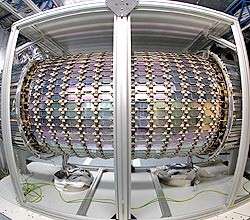Heart of world’s biggest physics experiment leaves Oxford

Tracker (SCT), the heart of the biggest physics collaboration in the world, left Oxford today for its new home at the European Particle Physics Laboratory, CERN, near Geneva.
Picture: One of four barrels, covered in 2112 silicon modules, that make up the SCT detector.
At CERN, physicists from around the world are assembling the Large Hadron Collider (LHC) which will send two counter-rotating beams of particles round an underground ring at 99.999999 per cent of the speed of light. When the beams are brought into collision, a shower of new particles will be produced reproducing conditions similar to those immediately after the Big Bang. These will be studied at four detectors around the ring. The largest of these detectors is called ATLAS and at its heart lies the SCT tracking the movements of the charged particles produced in the high-energy collision.
The SCT detector consists of a central region and two end caps. The central region is formed of four concentric barrels, covered with 2112 silicon modules (30 square metres worth). The modules were produced by collaborators in different countries and sent to Oxford’s Department of Physics for precision assembly. To be assembled, each of the fragile silicon modules had to be mounted on an ultra-lightweight carbon fibre cylinder using a specialised robot.
Each silicon module has 1536 channels, where each channel is a separate detector element which is connected by a wire bond to an individual channel of an ASIC (application specific integrated circuit) which contains all the read out electronics. Dr Richard Nickerson, who led assembly of the SCT at Oxford, said: ‘The assembly of the SCT barrels has proved to be a very challenging project and so we are all extremely pleased to see it reach a successful conclusion with 99.5 per cent of the 3 million channels working – even more than we hoped for as we had built in an element of redundancy.’
The SCT will track the positions of charged particles passing through the detector with an accuracy of better than 20 microns (less than the diameter of a human hair) over one metre. The information obtained by the SCT will form a crucial part of the data gathered by the full ATLAS Detector system and will be essential in the task of unravelling the physics in high energy particle collision. Other sections of the ATLAS detector will pick up other particle properties. Between them, the different sections should allow a complete picture to be formed.
The ATLAS experiment is the world’s largest collaboration in physical sciences, involving more than 1800 scientists from around the world. The detector measures 44 metres long and 22 metres high, as large as a five-story building, and weighs 7000 tons. Yet at its heart, where the SCT will operate, narrow beams of particles will be focussed to collide in an area much less than one square mm. Out of nearly 1000 million collisions a second, only a few will have the special characteristics that might lead to new discoveries.
Dr Tony Weidberg, co-investigator on the SCT project, said: ‘It has been both a privilege and a challenge to play our part in the world’s largest physics collaboration. We now eagerly await the full assembly of the Atlas detector and the start of the LHC in two years time which will allow us to better study the nature of the Universe.’
















